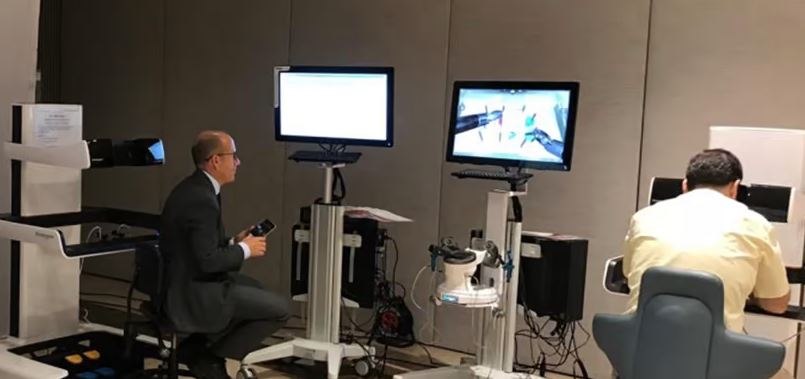William Jessup University Achieves 94% Rack Space Reduction and Easy Scalability by Selecting Nutanix Converged Solution

Customer Company Size
Mid-size Company
Region
- America
Country
- United States
Product
- Nutanix Virtual Computing Platform
- Veeam’s Replication & Backup
Tech Stack
- VMware
- SQL Server
- Windows web servers
- Linux library catalog
Implementation Scale
- Enterprise-wide Deployment
Impact Metrics
- Cost Savings
- Energy Saving
- Productivity Improvements
Technology Category
- Infrastructure as a Service (IaaS) - Cloud Computing
- Infrastructure as a Service (IaaS) - Cloud Storage Services
Applicable Industries
- Education
Applicable Functions
- Business Operation
Use Cases
- Remote Asset Management
- Virtual Training
Services
- System Integration
About The Customer
William Jessup University is a private Christian liberal arts college located in Rocklin, California. The university is experiencing rapid growth, with nearly 1,300 students and faculty. It offers 19 graduate and undergraduate degrees, including business, psychology, teaching, ministry, creative arts, and biology. Originally established in 1939 as a Bible college in San Jose, California, the institution later added liberal arts degrees and moved to its current location in Rocklin in 2004. The university is part of the Sacramento metropolitan area and is committed to providing a comprehensive education that integrates faith and learning. With a focus on academic excellence and spiritual development, William Jessup University aims to prepare students for leadership and service in their chosen fields.
The Challenge
The servers and storage infrastructure at William Jessup University were strained due to years of limited IT budgets. The college had 34 servers, 20 of which were virtualized with VMware, and the rest were standalone physical servers. The hardware was aging, with some already out of warranty. Memory capacity on the VMware hosts was over-provisioned by 2x, resulting in near-constant ballooning issues. The processors in the hosts were mixed Intel and AMD, which could not support failover using VMware HA. The primary storage system was a 10-year-old HP SAN with a single controller and only 2.5 TB of capacity. The dramatic growth in student enrollment in recent years meant more resources were needed for IT to meet the surge in demand for more performance, capacity, and a disaster recovery initiative. The IT department wanted to upgrade storage and had narrowed down their choice between Nimble and Tegile hybrid flash storage systems. However, they learned about the Nutanix converged compute and storage architecture, which intrigued them and caused them to reconsider their options.
The Solution
The IT team at William Jessup University decided to implement the Nutanix Virtual Computing Platform (NX-3050 model) to address their infrastructure challenges. Nutanix's solution offered a converged compute and storage architecture that could solve multiple issues at a price close to the storage-only proposals they were considering. The Nutanix platform includes flash-based hybrid storage, which meant they would not lose out on storage capabilities. Additionally, the integrated compute nodes provided cost savings over separate server purchases. The per-node scalability of the system made it easy to use and expand. The installation of the Nutanix appliance was seamless, taking just 6 hours to get the system up and running. With careful planning and preparation, the team was able to migrate workloads from 30 servers to the Nutanix appliance with only one hour of planned downtime. The user community, which operates 24/7 on a college campus, did not experience any disruption. The old servers were removed, except for three that now function as VMs to host disaster recovery targets using Veeam’s Replication & Backup software. This setup, along with automatic node failover in the Nutanix cluster, provides high availability, disaster recovery, and continuity of service for staff and students.
Operational Impact
Quantitative Benefit

Case Study missing?
Start adding your own!
Register with your work email and create a new case study profile for your business.
Related Case Studies.

Case Study
Revolutionizing Medical Training in India: GSL Smart Lab and the LAP Mentor
The GSL SMART Lab, a collective effort of the GSL College of Medicine and the GSL College of Nursing and Health Science, was facing a challenge in providing superior training to healthcare professionals. As clinical medicine was becoming more focused on patient safety and quality of care, the need for medical simulation to bridge the educational gap between the classroom and the clinical environment was becoming increasingly apparent. Dr. Sandeep Ganni, the director of the GSL SMART Lab, envisioned a world-class surgical and medical training center where physicians and healthcare professionals could learn skills through simulation training. He was looking for different simulators for different specialties to provide both basic and advanced simulation training. For laparoscopic surgery, he was interested in a high fidelity simulator that could provide basic surgical and suturing skills training for international accreditation as well as specific hands-on training in complex laparoscopic procedures for practicing physicians in India.

Case Study
IoT platform Enables Safety Solutions for U.S. School Districts
Designed to alert drivers when schoolchildren are present, especially in low-visibility conditions, school-zone flasher signals are typically updated manually at each school. The switching is based on the school calendar and manually changed when an unexpected early dismissal occurs, as in the case of a weather-event altering the normal schedule. The process to reprogram the flashers requires a significant effort by school district personnel to implement due to the large number of warning flashers installed across an entire school district.

Case Study
Implementing Robotic Surgery Training Simulator for Enhanced Surgical Proficiency
Fundacio Puigvert, a leading European medical center specializing in Urology, Nephrology, and Andrology, faced a significant challenge in training its surgical residents. The institution recognized the need for a more standardized and comprehensive training curriculum, particularly in the area of robotic surgery. The challenge was underscored by two independent studies showing that less than 5% of residents in Italian and German residency programs could perform major or complex procedures by the end of their residency. The institution sought to establish a virtual reality simulation lab that would include endourological, laparoscopic, and robotic platforms. However, they needed a simulator that could replicate both the hardware and software of the robotic Da Vinci console used in the operating room, without being connected to the actual physical console. They also required a system that could provide both basic and advanced simulation training, and a metrics system to assess the proficiency of the trainees before they performed surgical procedures in the operating theater.

Case Study
Edinburgh Napier University streamlines long-distance learning with Cisco WebEX
• Geographically dispersed campus made in-person meetings costly and inconvenient.• Distance-learning programs in Malaysia, India, and China required dependable, user-friendly online tools to maximize interaction in collaborative workspaces.• Virtual learning environment required a separate sign-in process, resulting in a significant administrative burden for IT staff and limited adoption of collaboration technology.

Case Study
8x increased productivity with VKS
Before VKS, a teacher would spend a lot of time showing a group of 22 students how to build a set of stairs within a semester of 120 hours. Along with not leaving the teacher much time to provide one-on-one support for each student to properly learn carpentry, it also left a considerable amount of room for error. Key information would be misinterpreted or lost as the class was taught in the typical show-and-tell way.

Case Study
Scalable IoT Empowering GreenFlex's Sustainable Growth
GreenFlex, a company that supports sustainable development, decarbonization, and energy efficiency, faced several challenges in its quest to expand its business. The company needed to deploy a robust and sustainable IoT technology to support its growth. It was crucial for them to monitor and control devices at customer sites in a safe and reliable manner. They also needed to integrate devices across a range of communication protocols and gather and act on data to meet efficiency targets. GreenFlex had previously built IoT capabilities into its digital platform, GreenFlexIQ, to monitor and manage customer sites remotely. However, they soon realized that they needed a new platform to support their ambitions. They needed a platform that could scale to connect more devices for production management and make it easier for the operations team to manage devices in the field.






